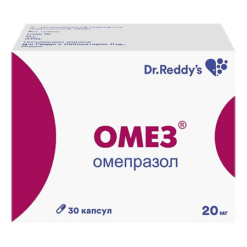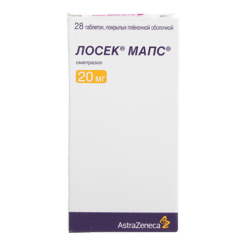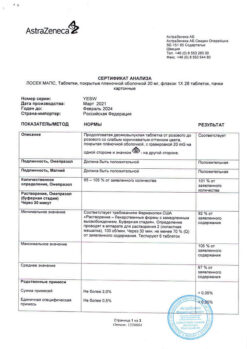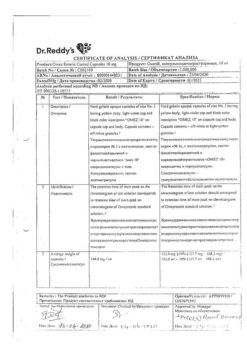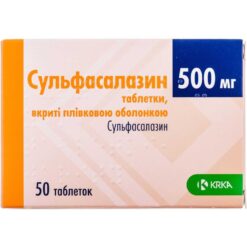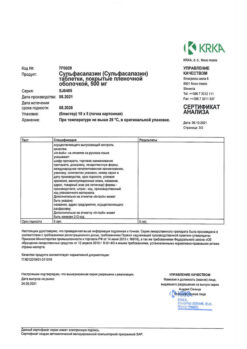No products in the cart.
Omeprazole 20 mg, 10 pcs.
€1.00
Out of stock
(E-mail when Stock is available)
EAN: 4607027760434
SKU: 225560
Categories: Medicine, Stomach, intestines, liver, Ulcer and gastritis
Description
Omeprazole has a highly selective mechanism of action resulting in decreased gastric juice secretion. It is a specific proton pump inhibitor of gastric parietal cells. The action of the drug comes quickly and is mediated by reversible inhibition of gastric juice secretion. Omeprazole is a weak base. It is concentrated in acid environment of secretory tubules of parietal cells of gastric mucosa, activates and inhibits proton pump enzyme H+-K+-ATP-ase.
The effect of omeprazole on the last stage of the process of hydrochloric acid formation in the stomach is dose-dependent and provides highly effective inhibition of basal and stimulated hydrochloric acid secretion regardless of the stimulating factor.
Omeprazole with daily oral administration provides rapid and effective inhibition of daytime and nighttime hydrochloric acid secretion. The maximum effect is achieved within 4 days of treatment. In patients with duodenal ulcer, omeprazole in 20 mg dose causes stable reduction of 24-hour gastric acidity by at least 80%. This achieves a 70% reduction in mean Cmax hydrochloric acid after pentagastrin stimulation for 24 hours.
In patients with duodenal ulcer, omeprazole at a daily dose of 20 mg maintains intragastric acidity at pH>3 for an average of 17 h.
The inhibition of hydrochloric acid secretion depends on the AUC of omeprazole and not on the plasma concentration of the drug at a given time.
Omeprazole has a bactericidal effect against Helicobacter pylori in vitro. Eradication of Helicobacter pylori when using omeprazole in combination with antibacterial agents is accompanied by rapid elimination of symptoms, a high degree of healing of gastrointestinal mucosal defects and long-term remission of ulcer disease, which reduces the probability of complications such as bleeding as effectively as continuous maintenance therapy.
Indications
Indications
Active ingredient
Active ingredient
How to take, the dosage
How to take, the dosage
Interaction
Interaction
Absorption of some drugs may be altered due to decreased acidity of the gastric environment.
As with other drugs that inhibit hydrochloric acid secretion or antacids, treatment with omeprazole may lead to decreased absorption of posaconazole, erlotinib, ketoconazole or itraconazole, as well as increased absorption of digoxin. Concomitant use of omeprazole at a dose of 20 mg once daily and digoxin increases digoxin bioavailability by 10%.
Concomitant use of omeprazole with clopidogrel showed a decrease in plasma levels of the active metabolite clopidogrel by 46% on day 1 and by 42% on day 5 of treatment, and administration of omeprazole and clopidogrel at different times does not exclude interaction of these drugs. It is likely that the observed effect is due to the inhibitory effect of omeprazole on the CYP2C19 isoenzyme.
The concomitant use of omeprazole with drugs such as atazanavir and nelfinavir is not recommended because their plasma concentrations are reduced when combined with omeprazole.
An increase in plasma concentrations of tacrolimus has been reported with omeprazole. Close monitoring of plasma concentrations of tacrolimus is necessary, as well as monitoring of renal function (RF), and adjusting the dose of tacrolimus if necessary.
No interaction with food or antacids has been identified.
Because omeprazole is metabolized in the liver involving the CYP2C19 isoenzyme, elimination of diazepam, warfarin (R-warfarin), cilostazol and phenytoin may be delayed. Monitoring of patients taking phenytoin and warfarin is recommended; doses of the aforementioned drugs may need to be reduced. However, concomitant treatment with the drug at a daily dose of 20 mg has no effect on plasma concentrations of phenytoin in patients taking the drug long-term; concomitant treatment with Omeprazole Zentiva at a daily dose of 20 mg has no effect on coagulation time in patients taking long-term warfarin.
Omeprazole does not affect metabolism of drugs metabolized by CYP3A4 isoenzymes, such as cyclosporine, lidocaine, quinidine, estradiol, erythromycin and budesonide. Plasma concentrations of omeprazole and clarithromycin increase with concomitant use of these drugs.
Drugs which inhibit CYP2C19 and CYP3A4 isoenzymes, such as voriconazole, when used concomitantly with omeprazole may increase plasma concentrations of omeprazole due to a decreased metabolic rate of the drug. Patients with impaired liver function may require dosage reduction with long-term use of Omeprazole Zentiva.
Drugs inducing CYP2C19 and CYP3A4 isoenzymes, such as rifampicin and preparations of St. John’s wort, when used concomitantly with omeprazole may decrease the plasma concentration of omeprazole by accelerating the metabolism of omeprazole.
Special Instructions
Special Instructions
Before starting therapy, it is necessary to rule out the presence of a malignant process (especially with gastric ulcer), since treatment, by masking symptoms, may delay the correct diagnosis. If there is no improvement within 5 days of starting Omeprazole Zentiva, or if heartburn worsens, discontinue treatment and consult a physician.
Patients aged 45 years and older with first-time heartburn symptoms should only take Omeprazole Zentiva after consultation with their physician. Omeprazole Zentiva should not be taken without medical supervision if any of the following symptoms or conditions are present:
Contraindications
Contraindications
Side effects
Side effects
The side effects of omeprazole are usually mild and reversible. The following side effects are possible and are divided into systemic organ classes according to the classification of the Medical Dictionary of Regulatory Affairs (MedDRA). The WHO classification was used to indicate the frequency of side effects: very common (â¥10%), common (â¥1% and < 10%), infrequent (â¥0.1% and < 1%), rare (â¥0.01% and < 0.1%), very rare (< 0.01%), unknown frequency (the frequency of side effect cannot be determined from available data).
Hematopoietic system: rarely – leukopenia, thrombocytopenia; very rarely – agranulocytosis, pancytopenia.
The immune system: rare – hypersensitivity reactions (e.g., fever, angioedema, anaphylactic reaction/anaphylactic shock).
Metabolic disorders: rare – hyponatremia; unknown frequency – hypomagnesemia.
Mental disorders: infrequent – insomnia; rare – agitation, confusion, depression; very rare – aggression, hallucinations.
Nervous system disorders: often – headache; infrequent – dizziness, paresthesia, somnolence; rarely – taste disorders.
An organ of vision: rarely – blurred vision.
Hearing organ and labyrinth disorders: infrequent – dizziness.
Respiratory system: rarely – bronchospasm.
The digestive system: often – diarrhea, constipation, nausea, vomiting, flatulence, abdominal pain; infrequent – increased liver enzymes activity; rare – dry mouth, stomatitis, gastrointestinal candidiasis, hepatitis (with or without jaundice); very rare – liver failure, encephalopathy in patients with liver disease.
Skin and subcutaneous tissue disorders: infrequent dermatitis, pruritus, rash, urticaria; rare alopecia, photosensitization; very rare erythema multiforme, Stevens-Johnson syndrome, toxic epidermal necrolysis.
Muscular system: infrequent fractures of the hip, wrist and vertebrae; rare – arthralgia, myalgia; very rare – muscle weakness.
Urinary system disorders: rarely – interstitial nephritis.
Gender and mammary system disorders: very rare – gynecomastia.
General disorders and disorders at the site of administration: infrequent – malaise, peripheral edema; rarely – increased sweating.
Cases of gastric glaundular cysts have been reported during long-term treatment with proton pump inhibitors (consequence of inhibition of hydrochloric acid secretion, benign reversible in nature).
Overdose
Overdose
In adults, a single dose of 560 mg of omeprazole has caused moderate intoxication symptoms. A case has been described in which a single dose of 2400 mg of omeprazole did not cause any severe toxic symptoms. The elimination rate of the drug did not change with increasing doses (first-order kinetics), and no specific treatment was required.
Symptoms: dizziness, confusion, apathy, depression, headache, tachycardia, nausea, vomiting, flatulence, diarrhea,
Treatment: conducting symptomatic therapy; if necessary – gastric lavage, prescription of activated charcoal.
Similarities
Similarities
Additional information
| Shelf life | 2 years |
|---|---|
| Conditions of storage | The drug should be kept out of reach of children at a temperature not exceeding 25 ° C. |
| Manufacturer | Ozon, Russia |
| Medication form | capsules |
| Brand | Ozon |
Other forms…
Related products
Buy Omeprazole 20 mg, 10 pcs. with delivery to USA, UK, Europe and over 120 other countries.



